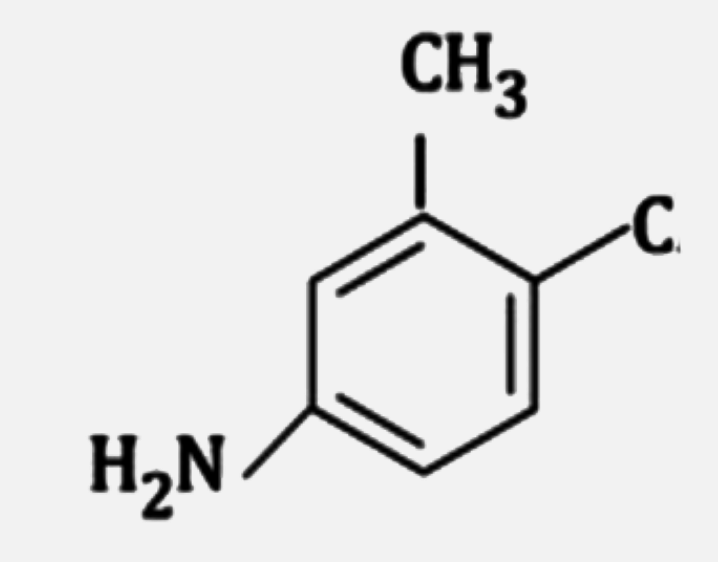From the following sequence of reactions,
[A] (C6H12)HCl−−→(B)(C6H13Cl)+(C)(C6H13Cl) react with AgNO3 to give white ppt.
[B] Alc.KOH−−−−−→ (D) (An isomer of A) gives positive test with Br2/CCl4
[D] Ozonolysis−−−−−→ (E) gives positive iodoform test and negative Fehling's test .
[A] Ozonolysis−−−−−→(F)+(G) both F and G give positive Tollen's test.
[F]+[G]Conc.NaOH−−−−−−−−→ΔHCOONa+alcohol
The structure of C is :




The correct Answer is:C
To determine the structure of compound C from the given sequence of reactions, we can follow these steps:
Step 1: Analyze Compound A
- Given: The molecular formula of A is C6H12.
- Degree of Unsaturation:
Degree of Unsaturation=(n+1−m)2=(6+1−12)2=−52=1
This indicates that A has either one double bond or one ring.
Step 2: Identify the Reaction of A with HCl
- Reaction: A+HCl→B+C
- Result: B is C6H13Cl. This indicates that A is likely an alkene, which reacts with HCl to form a chloroalkane.
Step 3: Identify Isomers B and C
- Isomers: Since B and C are both C6H13Cl, they can be structural isomers resulting from the addition of HCl to A.
Step 4: Analyze the Reaction of B with Alcoholic KOH
- Reaction: BAlc.KOH−−−−−−→D
- Result: D is an isomer of A and should also be an alkene.
Step 5: Ozonolysis of D
- Reaction: DOzonolysis−−−−−−→E
- Result: E gives a positive iodoform test and a negative Fehling's test, indicating that E is likely a methyl ketone.
Step 6: Ozonolysis of A
- Reaction: AOzonolysis−−−−−−→F+G
- Result: Both F and G give a positive Tollen's test, indicating they are aldehydes.
Step 7: Identify the Products of F and G with NaOH
- Reaction: F+GConc.NaOH,Δ−−−−−−−−−→HCOONa+alcohol
- Result: This indicates that F and G undergo a Cannizzaro reaction, which occurs in compounds without alpha hydrogens.
Step 8: Determine the Structure of C
- Conclusion: Since C is a product of the reaction of A with HCl, and considering the structure of A, we can deduce that C must be a chloroalkane that is a structural isomer of B. Given the reactions and tests, C is likely to be a primary or secondary alkyl chloride.
Final Structure of C
- The structure of C can be deduced to be a secondary or primary alkyl chloride based on the reactions and the fact that it gives a white precipitate with AgNO3 (indicating a good leaving group).
- Given: The molecular formula of A is C6H12.
- Degree of Unsaturation:
Degree of Unsaturation=(n+1−m)2=(6+1−12)2=−52=1
This indicates that A has either one double bond or one ring.
- Reaction: A+HCl→B+C
- Result: B is C6H13Cl. This indicates that A is likely an alkene, which reacts with HCl to form a chloroalkane.
- Isomers: Since B and C are both C6H13Cl, they can be structural isomers resulting from the addition of HCl to A.
- Reaction: BAlc.KOH−−−−−−→D
- Result: D is an isomer of A and should also be an alkene.
- Reaction: DOzonolysis−−−−−−→E
- Result: E gives a positive iodoform test and a negative Fehling's test, indicating that E is likely a methyl ketone.
- Reaction: AOzonolysis−−−−−−→F+G
- Result: Both F and G give a positive Tollen's test, indicating they are aldehydes.
- Reaction: F+GConc.NaOH,Δ−−−−−−−−−→HCOONa+alcohol
- Result: This indicates that F and G undergo a Cannizzaro reaction, which occurs in compounds without alpha hydrogens.
- Conclusion: Since C is a product of the reaction of A with HCl, and considering the structure of A, we can deduce that C must be a chloroalkane that is a structural isomer of B. Given the reactions and tests, C is likely to be a primary or secondary alkyl chloride.
- The structure of C can be deduced to be a secondary or primary alkyl chloride based on the reactions and the fact that it gives a white precipitate with AgNO3 (indicating a good leaving group).
Similar Questions
(C6H12)HCl−−→B(C6H13Cl)+(C)
(B)Alc.KOH−−−−−→(D) [isomer of (A)]
View SolutionA(C6H12)HCl−−→B+C(C6H13C)
BalcKOH−−−−→D (isomer of A)
Dozonolysis−−−−−→E (it gives negative test with Fehling solution but responds to iodoform test).
Aozolysis−−−→F+G (Both give positive Tollen's but do not give iodoform test)
F+Gconc. NaOH−−−−−−→ HCOONa +a primary alcohol
Identify to A to GView Solution
Knowledge Check
- Question 1 - Select One
From the following sequence of reactions,
[A] (C6H12)HCl−−→(B)(C6H13Cl)+(C)(C6H13Cl) react with AgNO3 to give white ppt.
[B] Alc.KOH−−−−−→ (D) (An isomer of A) gives positive test with Br2/CCl4
[D] Ozonolysis−−−−−→ (E) gives positive iodoform test and negative Fehling's test .
[A] Ozonolysis−−−−−→(F)+(G) both F and G give positive Tollen's test.
[F]+[G]Conc.NaOH−−−−−−−−→ΔHCOONa+alcohol
The structure of compound D is :A B
B C
C D
D
- Question 2 - Select One
From the following sequence of reactions,
[A] (C6H12)HCl−−→(B)(C6H13Cl)+(C)(C6H13Cl) react with AgNO3 to give white ppt.
[B] Alc.KOH−−−−−→ (D) (An isomer of A) gives positive test with Br2/CCl4
[D] Ozonolysis−−−−−→ (E) gives positive iodoform test and negative Fehling's test .
[A] Ozonolysis−−−−−→(F)+(G) both F and G give positive Tollen's test.
[F]+[G]Conc.NaOH−−−−−−−−→ΔHCOONa+alcohol
The structure A and B respectively are :A B
B C
C D
D
- Question 3 - Select One
From the following sequence of reactions,
[A] (C6H12)HCl−−→(B)(C6H13Cl)+(C)(C6H13Cl) react with AgNO3 to give white ppt.
[B] Alc.KOH−−−−−→ (D) (An isomer of A) gives positive test with Br2/CCl4
[D] Ozonolysis−−−−−→ (E) gives positive iodoform test and negative Fehling's test .
[A] Ozonolysis−−−−−→(F)+(G) both F and G give positive Tollen's test.
[F]+[G]Conc.NaOH−−−−−−−−→ΔHCOONa+alcohol
The reaction involve in the F and G with the NaOH is :AReimer-Tiemann reactionBAldol condensationCCannizzaro reactionDPerkin reaction
Identify 'M' in the following sequence of reactions
C8H6Cl2O(M)NH3−−→C8H8ClNOBr2−−−→NaOH View Solution
View SolutionThe product B of the following sequence of reactions is
C6H5CONH2Br2−−−→NaOHANaNO2/HCl−−−−−−−−−→ 0−5∘C –––––––––––––––––––BView SolutionWhich of the following combinations give C6H5−CH3∣C∣CH2CH3−OH?
View Solution(A)H2O∗−−−→B+C, (B) and (C) both give +ve iodoform test. Compound (A) is
View SolutionConsider the following sequence of reactions
AC3H6Cl2alc.KOH−−−−−→ΔBB2H6−−−−−−→H2O2/ΘOHC,Aalc.KOH−−−−−→ΔC The compound A is :View Solution

